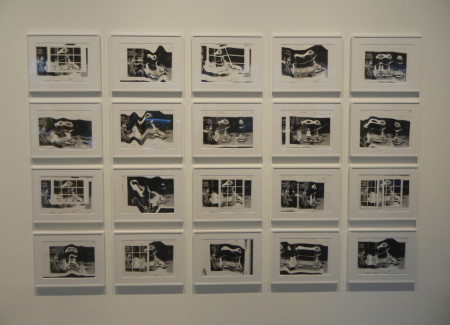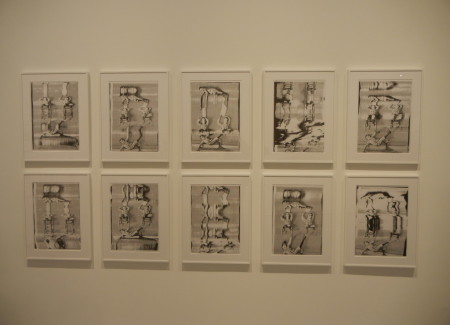JTF (just the facts): A total of 12 works and 1 installation, generally framed in white and matted, and hung against white walls in the main gallery space, a smaller back room, and above the entry desk. All of the works are manipulated photocopies, from single images to groups of 20, made between 1995 and 2005. Individual image sizes range from roughly 17×12 to 23×17 (or reverse) and all of the works are unique. (Installation shots below.)
Comments/Context: Coming on the heels of his sprawlingly diverse MoMA retrospective, this tightly edited show of Sigmar Polke’s late photocopier works allows us to follow a single line of the artist’s thinking much more deeply. While Polke’s interest in halftone printing, raster dots, and the breakdown of reproduced imagery into ambiguous abstract patterns can be traced all the way back to the mid 1960s, these works find him mixing gestural improvisation with mechanical repetition in new ways, extending that earlier deconstruction of imagery into more distorted territory. For those interested in reintroducing chance into digital photography, exploring glitches in automatic processes, or rethinking the use of the scanner, these works will be surprisingly relevant, regardless of their old school, office copy room technology.
Starting with black and white images drawn from books, magazines, and newspapers, Polke’s works feel like controlled exercises in repetition and serial iteration. Each frame is a riff on the original, contorting the ink into swirling undulations and blurs like Kertesz’ fun house mirror nudes, the photocopier becoming a musical instrument that Polke is pushing to its harmonic limits. Images are rippled and scrunched, elongated and twisted, turned and squiggled, pulled and doubled, in a seemingly endless variety of physical interventions. Individual raster dots become lines and waves, recalling a kind of psychedelic morphing – the difference is that these bends and bulges aren’t organic, they retain a kind of machined precision. Displayed as series and grids, the visual ideas build on each other in meditative sequence, an elastic form repeated in different amplitudes or a recognizable fragment (a face, a nude, a man being frisked) broken down step by step.
As individual works, these images might easily stand on their own and intrigue us with their wild virtuoso distortions. But when Polke puts them into groups, his photocopier gestures almost take on a narrative quality – the process itself is what we’re watching (not the product so much), and each iteration is a distinct moment in time and a separate set of artistic decisions, based on what has come before. When Polke forces us into a realm of typological comparison, there is a sense of time-based progression, of one warp kicking off an idea for the next until the creative momentum runs its course. Within a framework of constant repetition, he’s building up a set of discrete deconstructions, each one different but part of a larger visual melody. A wall-covering installation expands this idea even further, surrounding the viewer with variations of acrobatic kids balancing on chairs, turning a single original idea into a manic explosion of shimmering, shifting imagery.
While photocopied artworks and zines have long had air of rebelliousness, leveraging their imperfect reproductions into raw, gritty, underground moods, Polke’s photocopies feel more carefully expressionistic – he’s deliberately starting with something representational, and then meticulously pulling it apart until the original image becomes a kind of hallucination. It’s abstraction as incrementalism, where multiplication leads to ambiguity not clarity. In his hands, the photocopier becomes a source of magic, the formal raster dots revealing a hidden reserve of kinetic energy just waiting to be released.
Collector’s POV: The works in this show range in price from $44000 for the single images to $550000 for the largest set of 20, generally based on the number of prints in the work. Polke’s photographic works have only been intermittently available in the secondary markets in recent years. Prices have ranged from as little as $5000 for single images to as much as nearly $1M for larger groups of prints.














